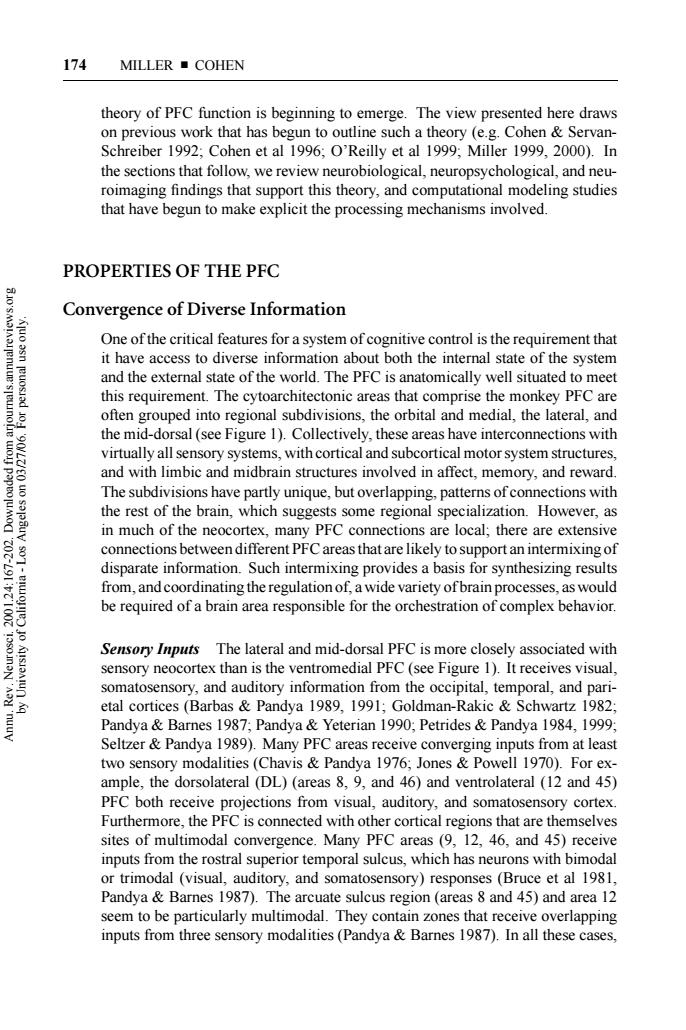正在加载图片...

174 MILLER■COHEN theory of PFC function is beginning to emerge.The view presented here draws on previous work that has begun to outline such a theory (e.g.Coh n Servan Schreiber 1992:Cohen et al 1996;O'Reilly et al 1999;Miller 1999,2000).In the sections that follow,we review neurobiological,neuropsychological,and neu- roimaging findings that support this theory,and computational modeling studies that have begun to make explicit the processing mechanisms involved. PROPERTIES OF THE PFC Convergence of Diverse Information One of the critical features for a system of cognitive control is the requirement that it have access to diverse information about both the internal state of the and the of the ord.The PFCs natomically well sit this requirement.The cytoarchitectonic areas that comprise the monkey PFC are often grouped into regional subdivisions,the orbital and medial,the lateral,and the mid-dorsal(see Figure 1).Collectively,these areas have interconnections with virtually all sensory systems,with cortical and subcortical motor system structures, and with limbic and midbrain structures involved in affect,me mory,and reward The subdivisions have partly unique,but overlapping.patterns of connections with the rest of the brain,which suggests some regional specialization.However,as in much of the neocortex many pFC connections are local there are extensive connections between different PFC areas that are likely to support an intermixing of di parate information.Such intermixing provides a basis for synthesizing results from,andc oordinating the regulation of ide variety ofbra s would be required of a brain area responsible Sensory Inputs The lateral and mid-dorsal PFC is more closely ass ociated with sensory neocortex than is the ventromedial PFC(see Figure 1).It receives visual somatosensory,and auditory information from the occipital,temporal,and pari etal cortices (Barbas Pandya 1989,1991;Goldman-Rakic Schwartz 1982 Pandya Barnes 1987:Pandya Yeterian 1990:Petrides Pandya 1984.1999: Pandya 199).Many PFC areas receive converging inputsfm two sen (Cha vis Pa 11970).Fo lethe(DL (areas8gana4 and(12级) PFC both receive projections from visual,auditory,and somatosensory cortex Furthermore,the PFC is connected with other cortical regions that are themselves sites of multimodal convergence.Many PFC areas (9,12,46,and 45)receive inputs from the ostral s mporal sulcus,which has n with bimoda or trimodal (visual,auditory,and somatosensory)responses (Br ce et al 1981 Pandya Barnes 1987).The arcuate sulcus region(areas 8 and 45)and area 12 seem to be particularly multimodal.They contain zones that receive overlapping inputs from three sensory modalities(Pandya Barnes 1987).In all these cases.P1: FXZ January 12, 2001 14:38 Annual Reviews AR121-07 174 MILLER ¥ COHEN theory of PFC function is beginning to emerge. The view presented here draws on previous work that has begun to outline such a theory (e.g. Cohen & ServanSchreiber 1992; Cohen et al 1996; O’Reilly et al 1999; Miller 1999, 2000). In the sections that follow, we review neurobiological, neuropsychological, and neuroimaging findings that support this theory, and computational modeling studies that have begun to make explicit the processing mechanisms involved. PROPERTIES OF THE PFC Convergence of Diverse Information One of the critical features for a system of cognitive control is the requirement that it have access to diverse information about both the internal state of the system and the external state of the world. The PFC is anatomically well situated to meet this requirement. The cytoarchitectonic areas that comprise the monkey PFC are often grouped into regional subdivisions, the orbital and medial, the lateral, and the mid-dorsal (see Figure 1). Collectively, these areas have interconnections with virtually all sensory systems, with cortical and subcortical motor system structures, and with limbic and midbrain structures involved in affect, memory, and reward. The subdivisions have partly unique, but overlapping, patterns of connections with the rest of the brain, which suggests some regional specialization. However, as in much of the neocortex, many PFC connections are local; there are extensive connections between different PFC areas that are likely to support an intermixing of disparate information. Such intermixing provides a basis for synthesizing results from, and coordinating the regulation of, a wide variety of brain processes, as would be required of a brain area responsible for the orchestration of complex behavior. Sensory Inputs The lateral and mid-dorsal PFC is more closely associated with sensory neocortex than is the ventromedial PFC (see Figure 1). It receives visual, somatosensory, and auditory information from the occipital, temporal, and parietal cortices (Barbas & Pandya 1989, 1991; Goldman-Rakic & Schwartz 1982; Pandya & Barnes 1987; Pandya & Yeterian 1990; Petrides & Pandya 1984, 1999; Seltzer & Pandya 1989). Many PFC areas receive converging inputs from at least two sensory modalities (Chavis & Pandya 1976; Jones & Powell 1970). For example, the dorsolateral (DL) (areas 8, 9, and 46) and ventrolateral (12 and 45) PFC both receive projections from visual, auditory, and somatosensory cortex. Furthermore, the PFC is connected with other cortical regions that are themselves sites of multimodal convergence. Many PFC areas (9, 12, 46, and 45) receive inputs from the rostral superior temporal sulcus, which has neurons with bimodal or trimodal (visual, auditory, and somatosensory) responses (Bruce et al 1981, Pandya & Barnes 1987). The arcuate sulcus region (areas 8 and 45) and area 12 seem to be particularly multimodal. They contain zones that receive overlapping inputs from three sensory modalities (Pandya & Barnes 1987). In all these cases, Annu. Rev. Neurosci. 2001.24:167-202. Downloaded from arjournals.annualreviews.org by University of California - Los Angeles on 03/27/06. For personal use only